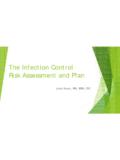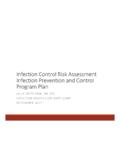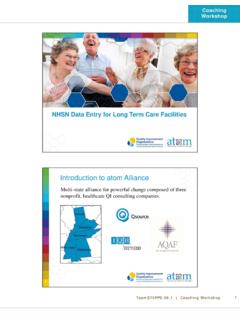Transcription of Andrea Flinchum, MPH, BSN, CIC Healthcare …
1 Andrea Flinchum, MPH, BSN, CIC. Healthcare -Associated Infection Prevention Program Manager Division of Epidemiology and Health Planning Infection Prevention Boot Camp September 26, 2017. Objectives Describe the components of the Infection Control Assessment Response (ICAR) tool Discuss common ICAR findings in Kentucky facilities and how they can be used to develop interventions aimed at improving the Infection Prevention and Control Program 2. ICAR. Developed by Centers for Disease Control and Prevention (CDC). Used to assist health departments in assessing infection prevention practices Guide quality improvement May also be used by Healthcare facilities to conduct internal quality improvement audits 3. Settings Tool was developed for the following settings: Acute Care Hospitals Long Term Care Outpatient Settings Hemodialysis Facilities 4.
2 Acute Care Hospitals Overview Section 1: Facility Demographics Section 2: Infection Control Program and Infrastructure Section 3: Direct Observation of Facility Practices (Optional). Section 4: Infection Control Guidelines and Other Resources 5. Facility Demographics 6. Domains for Gap Assessment Infection Control Program and Infrastructure Infection Control Training, Competency, and Implementation of Policies and Practices Systems to Detect, Prevent, and Respond to Healthcare -Associated Infections and Multidrug-Resistant Organisms (MDROs). 7. Infection Control Program and Infrastructure 8. Kentucky Results Infection Control Program and Infrastructure ACH - 69% (n=9) No gaps in domain LTACH - 100% (n=3) At least one gap in domain Critical Access Hospitals 100% (n=1) No gaps in domain 9. Infection Control Training, Competency, and Implementation of Policies and Practices 10.
3 Sub-Domains Hand Hygiene Personal Protective Equipment Prevention of Catheter-associated Urinary Tract Infection (CAUTI). Prevention of Central Line-associated Bloodstream Infection (CLABSI). Prevention of Ventilator-associated event (VAE). Injection Safety Prevention of Surgical Site Infection (SSI). Prevention of Clostridium difficile infection (CDI). Environmental Cleaning Device Reprocessing 11. Kentucky Results Hand Hygiene ACH 54% (n=7) No gaps in domain LTACH - 33% (n=1) No gaps in domain Critical Access Hospitals 100% (n=1) At least one gap in domain Hospitalhas a competency-based training program for hand hygiene Personnel are required to demonstrate competency with hand hygiene following each training 12. Kentucky Results Personal Protective Equipment (PPE). ACH 23% (n=3) No gaps in domain LTACH - 100% (n=3) At least one gap in domain Critical Access Hospitals 100% (n=1) At least one gap in domain Hospital has a competency-based training program for use of PPE.
4 Personnel are required to demonstrate competency with selection and use of PPE ( correct technique is observed by trainer) following each training. 13. Kentucky Results Prevention of CAUTI. ACH 100%(n=13) At least one gap in domain LTACH - 100% (n=3) At least one gap in domain Critical Access Hospitals 100% (n=1) At least one gap in domain Hospital has a competency-based training program for insertion of urinary catheters Training is provided at least annually Hospital has a competency-based training program for maintenance of urinary catheters Personnel are required to demonstrate competency with catheter maintenance ( correct technique is observed by trainer) following each training 14. Kentucky Results Prevention of CLABSI. ACH 85% (n=11) At least one gap in domain LTACH - 100% (n=3) At least one gap in domain Critical Access Hospitals 100% (n=1) At least one gap in domain Hospital provides feedback from audits to personnel regarding their performance for management of ventilated patients Hospital routinely audits (monitors and documents).
5 Adherence to recommended practices for management of ventilated patients ( suctioning, administration of aerosolized medications). 15. Kentucky Results Prevention of VAE. ACH 92% (n=12) At least one gap in domain LTACH - 100% (n=3) At least one gap in domain Critical Access Hospitals - Not applicable Hospital has a competency-based training program for insertion of central venous catheters Training is provided at least annually/Hospital routinely audits (monitors and documents) adherence to recommended practices for insertion Hospital has a competency-based training program for maintenance of central venous catheters Respondent can describe how feedback is provided/frequency of feedback 16. Kentucky Results Injection Safety ACH 100% (n=13) At least one gap in domain LTACH - 67% (n=2) At least one gap in domain Critical Access Hospitals - 100% (n=1) At least one gap in domain Hospital routinely audits (monitors and documents).
6 Adherence to safe injection practices Hospital has a drug diversion prevention program that includes consultation with the IP program when drug tampering (involving alteration and substitution) is suspected or identified to assess patient safety risks. 17. Kentucky Results Prevention of SSI. ACH 69% (n=9) At least one gap in domain LTACH - 67% (n=2) Not applicable Critical Access Hospitals - 100% (n=1) No gaps in domain Hospital routinely audits (monitors and documents). adherence to recommended infection control practices for SSI prevention 18. Kentucky Results Prevention of CDI. ACH 77% (n=10) At least one gap in domain LTACH - 100% (n=3) At least one gap in domain Critical Access Hospitals - 100% (n=1) No gaps in domain Hospital has specific antibiotic stewardship strategies in place to reduce CDI. Hospital educates patients and family members about the risk of CDI with antibiotics 19.
7 Kentucky Results Environmental Cleaning ACH 62% (n=8) At least one gap in domain LTACH - 100% (n=3) At least one gap in domain Critical Access Hospitals - 100% (n=1) No gaps in domain Hospital has policies that clearly define responsibilities for cleaning and disinfection of non-critical equipment, mobile devices, and other electronics ( ICU monitors, ventilator surfaces, bar code scanners, point-of-care devices, mobile work stations, code carts, airway boxes). 20. Kentucky Results Device Reprocessing ACH 54% (n=7) No gaps in domain LTACH - 100% (n=3) At least one gap in domain Critical Access Hospitals - 100% (n=1) No gaps in domain Hospital routinely audits (monitors and documents) adherence to reprocessing procedures for critical devices Audits occur in all locations where critical devices are reprocessed including locations where initial cleaning steps are performed IP program is consulted whenever new equipment or products will be purchased or introduced to ensure implementation of appropriate reprocessing policies and procedures 21.
8 Systems to Detect, Prevent, and Respond to Healthcare -Associated Infections and Multidrug- Resistant Organisms (MDROs). 22. Kentucky Results Systems for HAIs and MDROs ACH 69% (n=9) At least one gap in domain LTACH - 100% (n=3) At least one gap in domain Critical Access Hospitals - 100% (n=1) No gaps in domain Hospital has system in place for early detection and management of potentially infectious persons at initial points of entry to the hospital including rapid isolation as appropriate Hospital has system in place for INTER-facility communication of infectious status and isolation needs of patients prior to transfer to other facilities and prior to accepting patients from other facilities 23. Kentucky Results 7 Core Elements of Antibiotic Stewardship Program ACH 77% (n=10) Meet all 7 core elements LTACH - 67% (n=2) Meet all 7 core elements Critical Access Hospitals - 100% (n=1) Meet all 7.
9 Core elements 24. Observations 25. Long Term Care Overview Section 1: Facility Demographics Section 2: Infection Control Program and Infrastructure Section 3: Direct Observation of Facility Practices (Optional). Section 4: Infection Control Guidelines and Other Resources 26. Facility Demographics 27. Domains for Gap Assessment Infection Control Program and Infrastructure Healthcare Personnel and Resident Safety Surveillance and Disease Reporting Hand Hygiene PPE. Respiratory/Cough Etiquette Antibiotic Stewardship Infection Safety and Point of Care Testing Environmental Cleaning 28. Infection Control Program and Infrastructure 29. Kentucky Results Infection Control Program and Infrastructure LTC 100% (n=3) No gaps in domain Specified person responsible for coordinating the program Specified person has received training Written infection control policies Policies reviewed annually Written plan for emergency preparedness 30.
10 Kentucky Results Healthcare Personnel and Resident Safety LTC 67% (n=2) No gaps in domain The facility educates personnel on prompt reporting of signs/symptoms of a potentially transmissible illness to a supervisor The facility documents resident immunization status for pneumococcal vaccination at time of admission 31. Kentucky Results Surveillance and Disease Reporting LTC 100% (n=3) At least one gap in domain The facility has a written surveillance plan outlining the activities for monitoring/tracking infections occurring in residents in the facility The facility has a written plan for outbreak response which includes a definition, procedures for surveillance and containment, and a list of syndromes or pathogens for which monitoring is performed 32. Kentucky Results Hand Hygiene LTC 100% (n=3) At least one gap in domain The facility provides feedback to personnel regarding their hand hygiene performance PPE.






